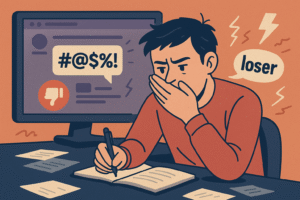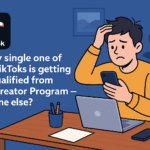
TikTok’s moderation system isn’t just flawed — it’s an insult to anyone with a functioning moral compass. It’s inconsistent, opaque, and most damningly, it’s predictable in all the wrong ways. If you’ve ever watched racist garbage slide through unscathed while your sarcastic “clown” emoji got you slapped with a violation, you’re not imagining things. You’re in the crosshairs of a system that isn’t just broken — it’s engineered to be this way.
This isn’t conspiracy. It’s what happens when machine learning moderates human interaction — and profit incentives outweigh fairness. Let’s dissect this nonsense and figure out what creators can actually do to protect themselves.
The Moderation Model: Surface-Level Policing, Deep-Level Damage
TikTok doesn’t actually care about intent — it cares about optics. AI flagging systems are trained to detect surface-level “toxicity” based on keywords, not context. So if you say something with even a whiff of edge or sarcasm, you’re likely to get flagged. But say something vile in coded language or use obscure spacing tricks? You can skate by.
Why? Because:
- The AI lacks nuance.
- It can’t evaluate tone.
- And it overcorrects to protect TikTok’s brand from advertiser backlash.
So what you get is compliance theater — a system that aggressively targets harmless comments while ignoring veiled bigotry.
TikTok’s Incentives Are Misaligned — On Purpose
Let’s be real: anger fuels engagement.
If a hateful comment sparks a 50-reply thread, TikTok sees that post as “highly engaging.” That drives reach. Reach drives session time. And session time? That’s cash. So the platform has every incentive not to fix its broken moderation because the chaos works in its favor.
Angry users = more watch time. More watch time = higher ad revenue.
The math checks out — even if the ethics don’t.
AI Isn’t the Only Problem: Human Moderators Are a Wild Card

You might think appealing your comment takes it to a higher power. Not really. TikTok’s human moderation is wildly inconsistent — some mods rubber-stamp everything, others have no clue what nuance is. One moderator’s “contextual sarcasm” is another’s “harassment.”
This inconsistency fuels paranoia. Creators start second-guessing every word, every emoji. And over time, that self-censorship erodes the whole point of being a creator in the first place.
Your Account Might Be Flagged — And You’d Never Know
Some creators are under silent review without ever being told. One too many flagged comments and you get quietly punished:
- Your reach drops.
- Your comments get instantly removed.
- You lose appeals automatically.
This “shadow moderation” is the digital version of getting ghosted by the algorithm. It’s nearly impossible to prove, but the signs are all there.
The Trolls Know How to Game the System
The people who should be moderated? They’ve adapted. Trolls use invisible characters, deliberate misspellings, and coded language to dodge detection. They can spew venom without tripping a single moderation wire.
Meanwhile, you call someone “dense” or “uninformed,” and boom — community guidelines violation.
The result? A platform where hate wins and honesty loses.
The Strategy Playbook: How to Fight Without Getting Flagged

If you’re serious about staying visible while calling out nonsense, you need to play smarter. Here’s how:
1. Use Mock Formality
Instead of calling someone “dumb,” say, “I fear your analysis lacks coherence.” It’s petty in a polite package — and it slips past moderation bots.
2. Swap Out Keywords
Some words are blacklisted by the system. Replace “idiot” with “uninformed.” Replace “clown” with “jester.” Get creative. The message still lands.
3. Engage Indirectly
Use quote-tweet-style replies: “Fascinating perspective — not sure I’ve ever seen that level of confidence from someone so objectively wrong.”
4. Screenshot the Outrage
Collect proof. If your comment gets taken down while a hate comment stays up, document it. This helps if your account faces review or you need to escalate.
5. Diversify Your Voice
Build audiences on Instagram, YouTube, Threads — anywhere you’re not subject to TikTok’s dystopian rules. Don’t let one flawed platform control your voice.
6. Report Strategically
If you’re dealing with real hate, organize. Mass reporting works better than single complaints. Don’t just scroll past the filth — clean it up together.
This Isn’t Just Moderation — It’s Manipulation
TikTok doesn’t want a safe space. It wants a profitable one. And if that means silencing creators who push back while letting trolls run wild — so be it.
It’s time we stopped acting surprised. The system behaves exactly as designed: prioritize engagement, suppress complexity, and monetize chaos.
But that doesn’t mean we roll over.
Speak Clearly. Speak Strategically. But Never Shut Up.
TikTok moderation is broken. That’s obvious. But silence isn’t the answer. If anything, this brokenness demands louder, sharper, more deliberate speech — not to provoke, but to expose.
- Know the rules.
- Master the loopholes.
- Stay calm, clever, and relentless.
Your voice deserves to be heard. Just don’t let TikTok decide when that’s allowed.
Because the minute we stop talking, the trolls — and the broken system — win.
Conclusion: The Price of Silence Is Too High
What TikTok calls “moderation” is often just control disguised as safety. The system doesn’t reward truth — it rewards passivity. It rewards silence. And for creators who care about authenticity, community, and actual dialogue, that’s unacceptable.
The platform won’t change until we force it to — with persistence, with clarity, and with communities that know how to spot the manipulation and beat it at its own game.
Don’t shut up. Get smarter. Get louder. Because the more we play nice while TikTok plays dirty, the more it wins — and we lose the one thing that made the internet powerful in the first place: our voice.



Pingback: TikTok Shadowbans Are Real — Here’s How to Break Free (Without Losing Your Mind) - Social Tips Master
Pingback: Why Original Creators Are Getting Disqualified from the Creator Rewards Program - Social Tips Master
Pingback: Why TikTok’s Collections Feature Is Broken (And How to Work Around It) - Social Tips Master
Pingback: TikTok’s Broken Moderation: Why Saying "Get Well Soon" Can Get You Banned While Hate Thrives - Social Tips Master
Pingback: TikTok Growth Lies You Need to Stop Believing (If You Actually Want to Grow) - Social Tips Master
Pingback: TikTok Is Banning Users for Saying ‘Ew’ — While Bots and Hate Speech Thrive - Social Tips Master
Pingback: The Creator Rewards Program Is a Scam — And Here’s the Ugly Truth About RPM - Social Tips Master